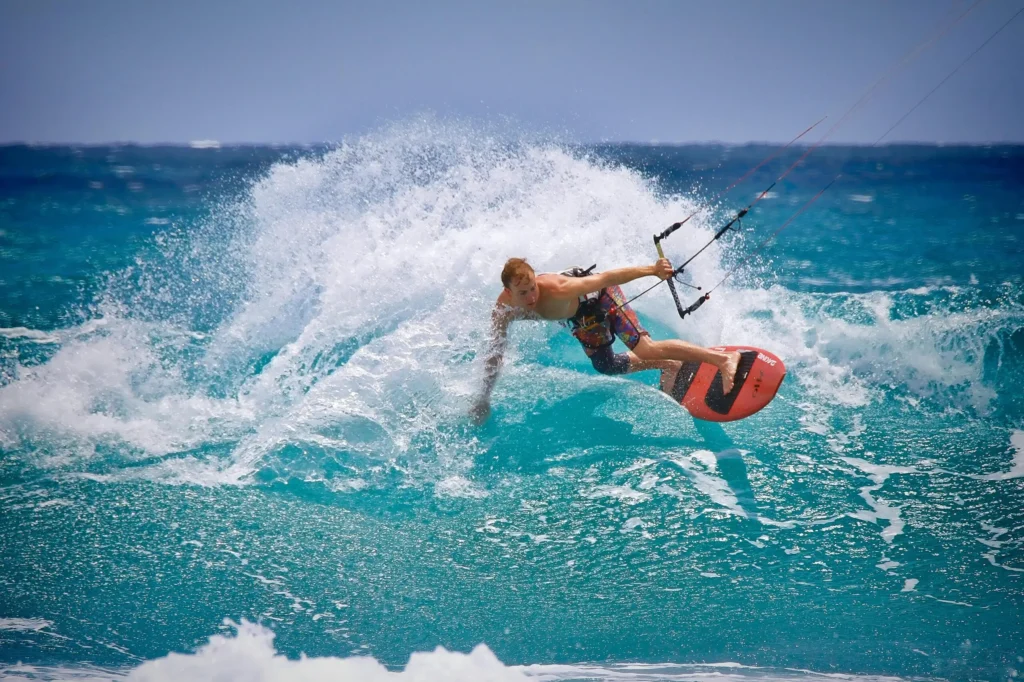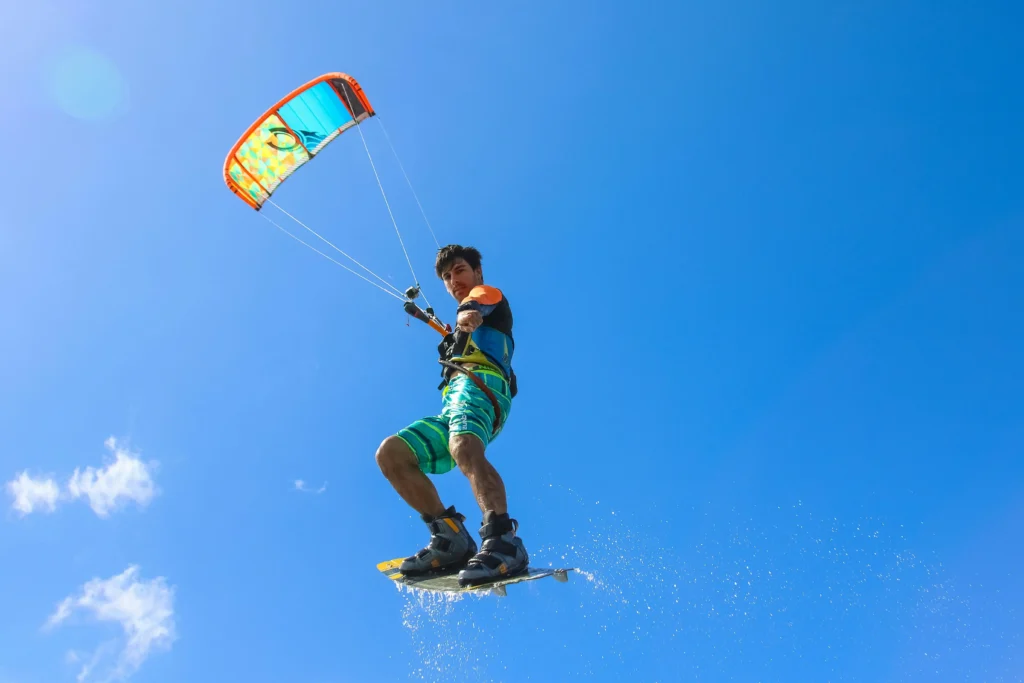Imagine harnessing the power of the wind with a high-tech kite, gliding effortlessly over crystal-clear waters, and performing gravity-defying tricks that seem to challenge the laws of physics. 🌊🪁 But how exactly does kitesurfing work in 2024? What advancements have transformed this sport, and how can you be part of this wind-powered revolution?
Have you ever dreamed of soaring across the waves, propelled by nothing but the wind and your own skill? 🏄♂️💨 In 2024, kitesurfing has evolved into an exhilarating fusion of cutting-edge technology and raw athletic prowess. This thrilling water sport is no longer just for daredevils; it’s become more accessible, safer, and more exciting than ever before.
In this blog post, we’ll dive deep into the world of modern kitesurfing. From the basics that’ll get you started to the latest techniques that’ll push your limits, we’ll explore it all. You’ll discover the technological marvels that are reshaping the sport, learn about its environmental impact, and get a glimpse into the competitive scene. So, buckle up (or should we say, strap in?) as we take you on an exhilarating journey through the ins and outs of kitesurfing in 2024!

Table of Contents
kitesurfing work In 2024: Basics
As you embark on your kitesurfing journey in 2024, you’ll find that the sport has evolved significantly. Let’s dive into the essential elements that make modern kite-surfing both thrilling and accessible.
Essential equipment upgrades
In 2024, kitesurfing equipment has undergone remarkable improvements. You’ll benefit from:
- Lightweight, durable materials
- Smart, integrated safety systems
- Compact, travel-friendly gear
These advancements make it easier for you to transport and set up your equipment, allowing more time on the water.
Modern kite designs and materials
Kite technology has leapt forward, offering you:
- Improved aerodynamics for better control
- Self-launching capabilities
- Eco-friendly, recyclable materials
Here’s a comparison of traditional and modern kite materials:
| Traditional Materials | Modern Materials (2024) |
| Dacron and Ripstop | Graphene-infused fabrics |
| Polyester | Recycled ocean plastics |
| Nylon | Bio-based composites |

Advanced board technology
You’ll find that 2024 kitesurfing boards are a far cry from their predecessors. Key features include:
- Shape-shifting capabilities for various conditions
- Built-in stabilizers for beginners
- Ultra-lightweight, high-performance cores
Safety gear innovations
Your safety is paramount in kitesurfing. In 2024, you’ll have access to:
- AI-powered impact prediction systems
- Inflatable protective gear
- Quick-release mechanisms with GPS tracking
These innovations ensure that you can enjoy kitesurfing with greater peace of mind and focus on improving your skills.
As we move forward, you’ll see how these basic elements set the stage for cutting-edge techniques that push the boundaries of what’s possible in kitesurfing.
kitesurfing work In 2024: Cutting-Edge Techniques
Now that you’re familiar with the basics of kitesurfing, let’s dive into the cutting-edge techniques that are revolutionizing the sport in 2024. These advancements are pushing the boundaries of what’s possible on the water and in the air.
New Riding Styles and Tricks
You’ll be amazed by the innovative riding styles that have emerged in recent years. From gravity-defying loops to intricate freestyle combinations, kitesurfers are constantly pushing the limits. Here’s a quick look at some popular new tricks:
- Mega Loops: Massive kite loops combined with high jumps
- Handle Passes: Mid-air kite control switches
- Board-Offs: Releasing and re-catching the board during jumps
- Kitefoil Freestyle: Combining foiling with traditional freestyle tricks
Improved Launching Methods
Launching your kite has become safer and more efficient with these new techniques:
- Self-Launch Systems: Allowing solo riders to launch safely
- Beach Anchors: Providing stability during setup
- Drone Assist: Using drones for initial kite elevation in low-wind conditions
Advanced Kite Control Techniques
You’ll find that mastering these advanced control techniques will significantly enhance your kitesurfing experience:
| Technique | Description | Benefit |
| One-Handed Control | Steering with a single hand | Frees up hand for tricks |
| Kite Looping | Rapid rotation of the kite | Increases jump height and hang time |
| Depower Mastery | Fine-tuning kite power on the fly | Adapts to changing wind conditions |
Precision Landing Strategies
Landing safely and accurately is crucial in kitesurfing. These strategies will help you nail your landings every time:
- Spot Landing: Aiming for a specific area on the water
- Soft Landing Technique: Using the kite to slow your descent
- Emergency Release Drills: Practicing quick releases for safety
As you explore these cutting-edge techniques, you’ll find your kitesurfing skills improving rapidly. Next, we’ll examine the technological advancements that are making these techniques possible and pushing the sport even further.
Technological Advancements
As kitesurfing continues to evolve, technological advancements are revolutionizing the sport in 2024. These innovations are enhancing safety, performance, and the overall experience for kiteboarders of all levels.
A. Smart kites with built-in sensors
Smart kites are transforming the way you ride. These cutting-edge kites come equipped with sensors that provide real-time data on wind speed, kite position, and line tension. This information is transmitted directly to your smartwatch or smartphone, allowing you to make instant adjustments for optimal performance and safety.
B. AI-powered wind prediction apps
Artificial Intelligence has made its way into kitesurfing, offering you unprecedented accuracy in wind forecasting. These apps analyze vast amounts of meteorological data to provide hyper-local wind predictions, helping you plan your sessions with confidence.
| Feature | Benefit |
| Hourly forecasts | Precise session planning |
| Spot-specific data | Tailored predictions for your location |
| Historical analysis | Helps identify optimal conditions |
C. GPS-enabled tracking systems
GPS technology has become an integral part of kitesurfing gear. These systems not only track your speed and distance but also provide valuable safety features:
- Real-time location sharing with emergency contacts
- Automated SOS alerts in case of accidents
- Route mapping for discovering new spots
D. Virtual reality training simulations
Virtual Reality (VR) is revolutionizing kitesurfing training. With VR simulations, you can:
- Practice techniques in a safe, controlled environment
- Experience various wind conditions without leaving home
- Receive instant feedback on your form and technique
These technological advancements are making kitesurfing safer, more accessible, and more enjoyable than ever before. As we move forward, we’ll explore how these innovations are shaping competitive kitesurfing in 2024.
Environmental Considerations
As kitesurfing grows in popularity, so does the need for environmental awareness. Kitesurfers must recognize their impact on marine ecosystems. In 2024, sustainable practices are more critical than ever. Many brands are innovating eco-friendly equipment, such as biodegradable kites and harnesses made from recycled materials. Additionally, kitesurfing communities are actively promoting clean-up initiatives and responsible riding to protect our oceans.
Competitive Kitesurfing in 2024
Competitive kitesurfing has taken center stage, with numerous events showcasing the sport’s top talents. The format of competitions has evolved, emphasizing not just skill but creativity and style. In 2024, the judging criteria have become more refined, incorporating elements like technical difficulty and artistic expression. Leading athletes are pushing the boundaries of the sport, inspiring newcomers and seasoned riders alike. Events like the World Kitesurfing Championships are anticipated to draw massive crowds, highlighting the sport’s growth and popularity.
Kitesurfing Destinations
When it comes to kitesurfing, the location can make all the difference:
Tarifa, Spain: Known for its consistent winds and vibrant kitesurfing community.
Maui, Hawaii: Offering stunning scenery and challenging conditions for advanced riders.
Cape Town, South Africa: A hotspot for both beginners and experts alike, with diverse conditions.
Additionally, hidden gems are emerging as kitesurfing spots, providing unique experiences away from the crowds. Exploring these locations can lead to unforgettable adventures.
Training and Skill Development
Training techniques have advanced significantly in 2024, with technology playing a key role. Virtual coaching platforms and mobile apps now offer tailored training programs, helping riders improve their skills at their own pace. For beginners, taking lessons from certified instructors remains crucial, while advanced kitesurfers can benefit from video analysis to refine their techniques. Emphasizing safety and skill progression ensures that all riders can enjoy the sport to its fullest.
Kitesurfing merges the thrill of surfing with the power of paragliding and windsurfing. The goal is to ride over the water while using wind power to perform jumps, tricks, and maneuvers. Let’s take a closer look at the essentials of kitesurfing:
1. Equipment Essentials
- Kite: The kite is the primary power source in kitesurfing. It comes in various sizes, with larger kites used for lighter winds and smaller kites for strong winds. Most kites are inflatable, allowing them to float on water, and they’re designed to relaunch easily.
- Board: A kitesurfing board is generally smaller and more buoyant than a surfboard. Types include twin-tip boards (bi-directional) for freestyle and trick riding, and directional boards, which are better for wave riding.
- Harness: Worn around the waist or hips, the harness attaches to the rider’s body and connects to the kite via a hook or loop, transferring the kite’s power to the body to reduce strain on the arms.
- Bar and Lines: The bar is the control center, with lines running from the bar to the kite. Moving the bar in specific directions steers the kite. Many bars feature a quick-release system for safety.
- Safety Leash and Release System: In emergencies, the safety release lets the kitesurfer detach the kite to avoid accidents.
- Pump: A hand or electric pump is used to inflate the kite’s bladders, giving it structure and allowing it to float.
2. Harnessing Wind Power
- Wind Direction: Wind direction and speed are crucial. Kitesurfers aim to ride at angles to the wind, called “cross-wind” or “side-wind,” rather than directly into or away from it.
- Control and Power Zones: Riders steer the kite within different areas, or “wind windows,” which range from low-power zones near the edge of the window to high-power zones directly downwind. By keeping the kite in certain areas of this window, kitesurfers can adjust speed and control.
3. Balancing on the Board
- Stance: Kitesurfing stance requires one foot in front and one in back, similar to snowboarding. Beginners often start with a wider stance for stability.
- Edging: This technique involves digging the edge of the board into the water to resist the pull of the kite, allowing riders to control speed and direction. Proper edging lets riders maintain stability and steer effectively.
4. Techniques for Speed and Tricks
- Jumping: Jumping is a signature move. Riders pull hard on the control bar while edging, which momentarily directs the kite upwards and creates lift. Timing and kite positioning are key to getting height and controlling descent.
- Turning (Gybes and Tacks): Turning is necessary when switching directions. A gybe involves turning the board while changing the kite’s direction, while a tack involves shifting the board’s nose into the wind. Both maneuvers require balance, precision, and kite control.
Conclusion
As we delve into kitesurfing in 2024, it’s clear that the sport is not just about the thrill of riding the waves. Environmental considerations, competitive growth, and evolving training techniques highlight the dynamic nature of kitesurfing today. Whether you’re a seasoned pro or a curious beginner, the world of kitesurfing offers endless opportunities for adventure and personal growth.
FAQ
1. How much wind is ideal for kitesurfing?
Typically, winds between 12-25 knots (14-29 mph) provide ideal conditions. Newcomers should start with winds around 12-15 knots to get a feel for kite control without excessive power.
2. Do I need to be a strong swimmer?
Yes, it’s important to be a confident swimmer, as falling and getting in the water are common. A good swimming ability ensures you can handle yourself in various water conditions.
3. How long does it take to learn kitesurfing?
On average, 6-12 hours of lessons over a few days can bring most people to a basic level of competence, depending on athletic ability, weather, and conditions. Mastery of techniques like jumps and tricks requires additional practice.
4. What’s the difference between kitesurfing and windsurfing?
Kitesurfing uses a kite and a smaller board, while windsurfing involves a sail attached directly to the board. Windsurfers typically need larger waves, while kitesurfers can operate in a range of wind conditions and on flat water.
5. Is kitesurfing dangerous?
As with any extreme sport, risks are present. With proper training, use of safety equipment, and adherence to local weather conditions, the risks are reduced significantly.
6. What is the best location to learn kitesurfing?
Calm, shallow waters with consistent side-onshore winds are ideal for beginners. Locations like Tarifa (Spain), Cabarete (Dominican Republic), and Maui (Hawaii) are popular for kitesurfing lessons.
7. Can you kitesurf in low wind?
While it’s possible to kite in lower winds (under 12 knots) using a larger kite, it’s generally not recommended for beginners, as maintaining control can be challenging.
8. Do I need specific physical fitness for kitesurfing?
Kitesurfing requires core strength, leg strength, and endurance. A moderate fitness level is sufficient for beginners, but more advanced riders may benefit from cross-training to improve balance and stamina.
9. Is it hard to relaunch the kite if it falls in the water?
Most modern kites are designed for easy water relaunch. With proper technique, getting the kite back into the air typically only takes a few seconds. However, strong or gusty winds can sometimes complicate this.
10. What is “kite looping,” and is it for beginners?
Kite looping is an advanced maneuver where the kite loops in the air, creating a powerful pull that can propel the rider forward or upward. It’s generally not for beginners due to the skill and control required.
